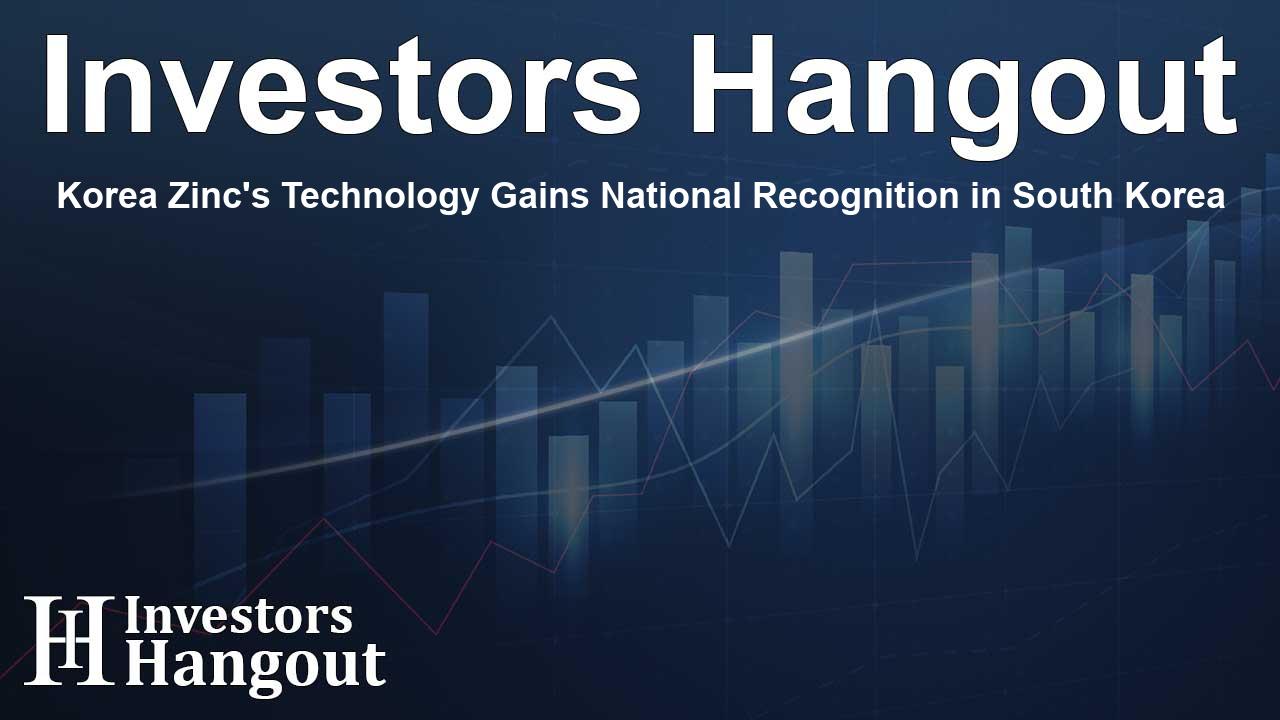Korea Zinc's Technology Gains National Recognition in South Korea

Korea Zinc's Technology Gains National Recognition
Korea Zinc (KRX:010130) has achieved a significant milestone as its precursor technology, essential for secondary batteries, is now recognized as both national core technology and national high-tech strategic technology by the Korean government. This acknowledgment positions Korea Zinc as a leader in the non-ferrous metal smelting industry.
Importance of Precursor Technology
This precursor technology, jointly developed with its subsidiary KEMCO, offers substantial technical and economic advantages not only locally but also on the global market. The government's designation emphasizes its potential to foster industrial growth while mitigating threats to national security that may arise from unauthorized technology transfers abroad.
Building a Reliable Supply Chain
With this designation, Korea Zinc is gearing up to create a robust self-sufficient supply chain for battery precursors, utilizing homegrown technology. This move is vital to establish local production capabilities that can support the burgeoning secondary battery industry, which is essential for various advanced technologies from electric vehicles to renewable energy systems.
Acknowledgment from Authorities
The Ministry of Trade, Industry, and Energy classified this technology under the electrical sector, emphasizing its strategic importance in enhancing competitiveness. This classification is part of a broader initiative to protect technologies that significantly contribute to national and economic security. Over 70 technologies across various sectors have already been recognized under this initiative.
Regulatory Implications
Korea Zinc will now implement stringent protective measures related to the export and investment in this technology. These measures will necessitate approvals for exports and any international partnerships involving mergers or joint ventures, ensuring that the technology's integrity is maintained.
Shifting Manufacturing Dependencies
Previously, domestic battery manufacturers relied heavily on imports for cathode active materials, with most precursors coming from external sources, particularly China. This dependency raises concerns over economic sovereignty and security, prompting Korea Zinc to accelerate local production initiatives.
Innovative Production Techniques
The company is innovating its production processes with the construction of a state-of-the-art nickel smelter in Ulsan through KEMCO. Expected to commence trial operations soon, this facility marks Korea Zinc’s commitment to creating a sustainable local supply chain for high-nickel precursors.
Pioneering Joint Ventures and Achievements
In collaboration with LG Chem, Korea Precursor Corporation (KPC) has emerged as a trailblazer in precursor production, employing groundbreaking methods that enhance production efficiency and quality. Their approach allows them to maximize the capacity of production processes, setting a competitive standard against rival firms.
Impact on Battery Industry
The advancements in precursor manufacturing are anticipated to have a profound impact, not only on Korea Zinc's operations but also on the entire domestic battery sector. The ability to produce high-quality precursors locally will significantly reduce reliance on imports and bolster economic security.
Contributions to the National Economy
Korea Zinc’s innovative technologies can potentially reshape the framework of the national industrial landscape by diversifying the supply chain of critical minerals necessary for battery manufacturing. This shift is vital for enhancing the country’s economic resilience and competitive stature globally.
Future Outlook
The designation of Korea Zinc’s precursor technology as a national asset reflects its critical role in shaping the future of the secondary battery ecosystem. By seeking self-sufficiency and security in manufacturing, Korea Zinc is poised to not only meet domestic needs but also set a precedent on the international stage.
Frequently Asked Questions
What is Korea Zinc's precursor technology?
Korea Zinc's precursor technology refers to the manufacturing process of key materials used in secondary batteries, particularly those with high nickel content for lithium-ion batteries.
Why has the Korean government designated this technology?
The technology has been recognized for its significant technical and economic value, as well as its potential implications for national security.
How does this designation impact Korea Zinc?
The designation allows Korea Zinc to strengthen its local production capabilities and protect its technology from potential leaks abroad.
What are the future plans for this technology?
Korea Zinc aims to enhance production efficiency and quality, while bolstering its local supply chain to reduce dependence on imports.
How is Korea Zinc collaborating with other companies?
Korea Zinc has formed joint ventures, notably with LG Chem, to innovate and improve precursor production processes, enhancing competitiveness in the market.
About Investors Hangout
Investors Hangout is a leading online stock forum for financial discussion and learning, offering a wide range of free tools and resources. It draws in traders of all levels, who exchange market knowledge, investigate trading tactics, and keep an eye on industry developments in real time. Featuring financial articles, stock message boards, quotes, charts, company profiles, and live news updates. Through cooperative learning and a wealth of informational resources, it helps users from novices creating their first portfolios to experts honing their techniques. Join Investors Hangout today: https://investorshangout.com/
Disclaimer: The content of this article is solely for general informational purposes only; it does not represent legal, financial, or investment advice. Investors Hangout does not offer financial advice; the author is not a licensed financial advisor. Consult a qualified advisor before making any financial or investment decisions based on this article. The author's interpretation of publicly available data shapes the opinions presented here; as a result, they should not be taken as advice to purchase, sell, or hold any securities mentioned or any other investments. The author does not guarantee the accuracy, completeness, or timeliness of any material, providing it "as is." Information and market conditions may change; past performance is not indicative of future outcomes. If any of the material offered here is inaccurate, please contact us for corrections.